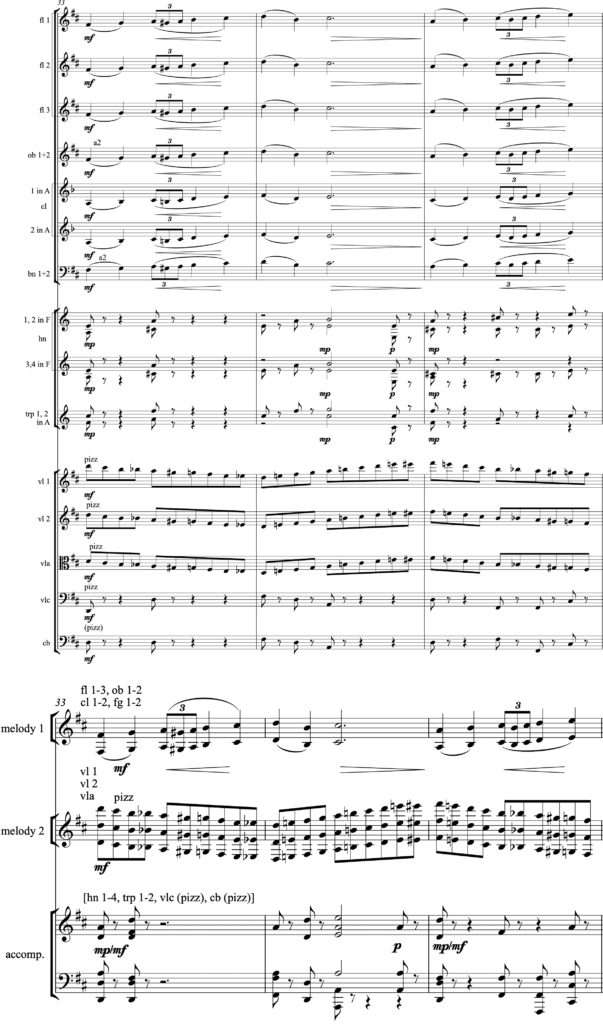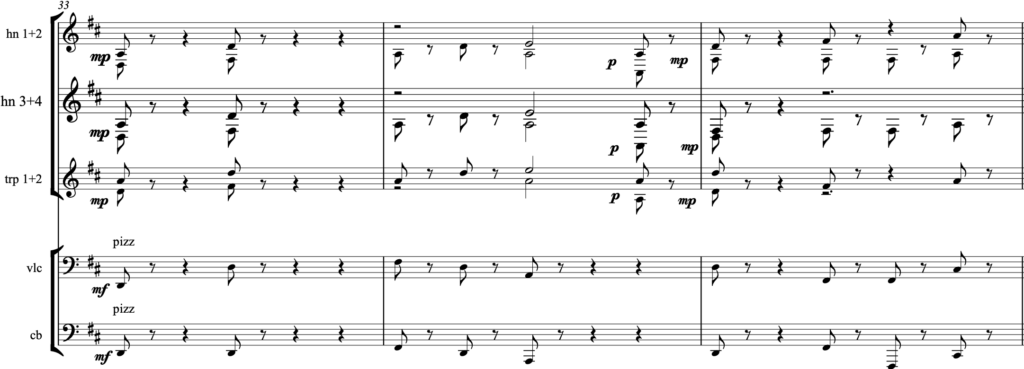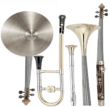1.1 Introduction
In this book orchestration analysis refers to the examination of how musical elements are distributed among different instruments within an orchestra, ensemble or any group of instruments. It involves analyzing how the elements of the music are positioned in relation to one another, how instruments are grouped together, and how different sections are related to each other. It helps to create an understand of how the individual instruments contribute to a given orchestration, and it provides insight into the creative decisions made by the composer and therebye enhances the appreciation of orchestration.
This book describes an approach to orchestration analysis called segment analysis. Segment analysis combines analyses of texture, orchestration methods, and perception. These three topics are in many ways closely related, as an orchestration must be an orchestration of something, a texture, and a texture like a melody, is only a melody because of our perception of it as such. Anyway, the three topics will, in order to keep them out of one another as much as possible, be introduced one by one, all though they are prerequisites for each other. Therfore chapter 2 will only introduce texture analysis. Here, a distinction is established between the texture of the music and its orchestration. In texture analysis, music is described in terms of textural elements, such as melody, chord progression, and accompaniment. Classical texture types, such as homophony, polyphony, and heterophony, are referred to throughout. But new textural elements – singular and compound elements – and with them, completely new texture types, are also introduced.
Texture analysis is then used in Chapters 3 and 4 to explain the ways in which a textural element (e.g., melody) in a musical texture can be orchestrated. Chapter 3 focuses on how an element can be realized and positioned within the soundscape, while Chapter 4 exemplifies strategies for vertical and horizontal doublings, combination hereof, and partial doublings.
After this, segment analysis is established in Chapter 5 as an analytical method dividing an orchestration into segments and sub-segments.
In this book, texture analysis, orchestration methods, and segment analysis emerge from the score through visual observations. But orchestration is as much, if not more, about it’s sounding. Auditory cues and knowledge about them through perception are used to put the segment analysis into perspective. This happens in Chapter 6, where the focus is on the relationship between the segment analysis and the constraints of our auditory perception. In addition, perception are in this chapter used to explain some basic issues in both texture and segment analysis.
Finally, Chapter 7 exemplifies how segment analysis can be used to identify some general orchestration strategies in three orchestral movements by Maurice Ravel, Witold Lutoslawski and Salvatore Sciarrino respectively.
1.2 Musical examples
The text will restrict itself to musical examples from no more than six orchestral movements. Even so, the textural types, orchestration methods and perceptual issues that are presented and discussed have relevance that goes far beyond these particular pieces. Nevertheless, it must be assumed that other works will reveal other types, methods, and perspectives.
The six movements in question are:
- Pyotr Ilyich Tchaikovsky: Symphony No. 6, 2nd movement (1893)
- Maurice Ravel: Rapsodie Espagnole, 2nd movement (1908)
- Igor Stravinsky: Symphony of Psalms, 1st movement (1930)
- Olivier Messiaen: Turangalîla Symphony, 1st movement (1948)
- Witold Lutoslawski: Livre pour orchestre, 3rd movement (1968)
- Salvatore Sciarrino: 4 Adagi, 1st movement (2007)
It is recommended that readers familiarize themselves with these movements before embarking on the reading. As the entire set of movements has a total duration of approximately 30 minutes, this is well worth the effort.
1.3 Edited notation
To increase the accessibility of musical examples and to illustrate the analyses, annotated and edited versions of the original scores will be used. The edited musical examples will contain all voices and doublings, but in a more economical layout with fewer staves. All information about dynamics, phrasing and articulation will be maintained (Fig. 1).

Figure 1. Tchaikovsky’s Symphony No. 6, 2nd movement. The original layout of the score at top and the edited version below.
The edited musical examples will be scored in the following way:
- Instruments that play in unison or participate in the same textural element will be organized on the same staff or, if necessary, on a single grand staff. A textural element could be, for example, a melody or an accompaniment (more about elements in Chapter 2).
- Textural elements will be scored from top to bottom depending on how dominant they are deemed to be in the overall soundscape, based on their musical character, register, activity level, and realized volume.
- All instruments (including transposing instruments) will be scored in concert pitch. Octave-transposing instruments will be scored at their actual sounding pitch.
- Names of instruments associated with a textural element will be listed above the relevant staff. When divided across multiple lines of text, the upper line will refer to instruments playing the top voice on the staff and the lower line will refer to instruments playing the bottom voice on the staff (Fig. 2).

Figure 2. Tchaikovsky’s Symphony No. 6, 2nd movement, excerpt. Flutes and oboes (on the upper line of text) play the top voice whereas clarinets and bassoons (on the lower line of text) play the bottom voice.
In Fig. 2, the upper notes in melody 1 are played by flutes 1-3 and oboes 1+2 in unison while the lower ones are played by clarinets 1+2 and bassoons 1+2 (also in unison). When the voicing of the instruments is so irregular that it can hardly be comprehensively described in the reduced notation, as shown in Figure 3 & 4, then the participating instruments are enclosed in square brackets.

Figure 3. Tchaikovsky’s Symphony No. 6, 2nd movement, the original parts (in c)

Figure 4. Tchaikovsky’s Symphony No. 6, 2nd movement, excerpt. The reduced score which hides the voicing marked with square brackets
Musical examples in which one or more textural elements have been omitted, will be labelled as excerpts in the figure legend. Yet, such excerpts will contain all the instruments belonging to the particular elements that are displayed including their dynamics, phrasing, and articulation markings.
The reader is encouraged to seek out the original scores in order to access the full level of detail.
